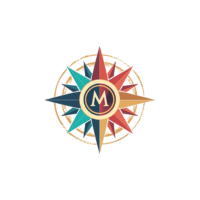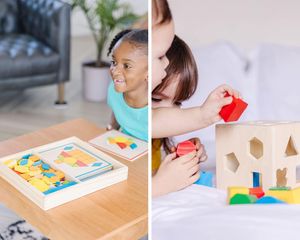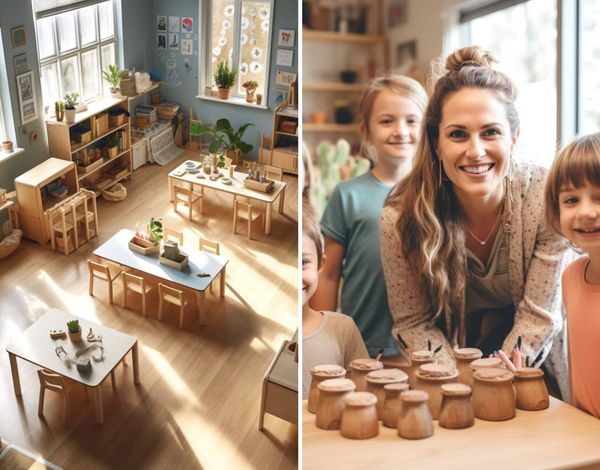Imagine standing at a crossroads, faced with the daunting task of choosing the right path for your child's education. The future of your little one's development and happiness hangs in the balance.
This was the scenario my wife and I found ourselves in as Christian (our eldest) approached school age. Navigating the labyrinth of educational options felt overwhelming, but our quest led us to a fascinating comparison: Montessori versus traditional education. If you’re at a similar position and are looking to gather more data, you’ll love that in this article, I’ll be diving into the key aspects of each system, arming you with the knowledge to make an informed decision for your family.

To help you navigate this critical decision, we've compiled the following key discussion points that we'll explore throughout the article:
- Unravel the history and philosophy behind Montessori and traditional education
- Discover the unique learning environments of Montessori and traditional classrooms
- Explore the distinct teaching methods and curriculum employed by each system
- Delve into the roles of teachers and students in Montessori and traditional education
- Examine how each approach fosters child development and social interaction
- Assess the differences in structure, scheduling, rewards, and discipline
- Compare the accessibility, cost, and benefits of Montessori and traditional education
- Learn how to choose the right school for your child based on your values and goals
Embark on a journey with me through the Montessori Compass as I uncover the similarities, differences, and hidden gems of both educational systems, empowering you to confidently choose the path that aligns with your family's values and aspirations.
History and Philosophy
Maria Montessori and Montessori Method
Let’s go back a little bit in time. Maria Montessori, born in 1870, was an extraordinary individual who initially resisted going into teaching, a profession available to women in the late 19th century. However, she later found her passion in education and developed her philosophy, now known as the Montessori Method. This method is based on the idea that children are inherently intelligent beings and should be treated with respect. It emphasizes the importance of a prepared environment, sensitive periods of learning, as well as independence and discovery for each child.
As I observed in this Nature article, one of the primary goals of Montessori education is to nurture children's natural curiosity and love of learning. Each child is given the freedom to explore and gain knowledge at their own pace, using hands-on, multi-sensory materials. This method of learning fosters creativity, critical thinking, and problem-solving skills.
Origins of Traditional Education
Traditional education has a long history, with its roots stemming from classical education practices and methods used in ancient Rome and Greece. Unlike Montessori education, traditional education often views children as empty vessels to be filled with information through a process of memorization, as stated in this GMN article.
In a traditional setting, the curriculum is often structured with little room for flexibility, and the teacher is responsible for imparting knowledge to the students. Students are expected to conform to established standards and practices, often learning through repetitive exercises and testing.
Some key aspects of traditional education include:
- Teacher-centered approach
- Curriculum determined by grade level
- Emphasis on memorization and testing
- Structured and rigid classrooms
In comparison, the Montessori Method offers a more child-centered learning experience which focuses on their needs, abilities, and interests. By facilitating a positive and nurturing educational environment, Montessori education allows children to develop essential skills at their own pace, ultimately fostering greater academic achievement and personal growth.
Learning Environment
Montessori Classroom
- Unique, thoughtfully designed environment for self-directed learning
- Prepared environment with carefully chosen materials catering to developmental needs
- Light-colored walls, minimal visual distractions
- Hands-on materials for learning through play and active participation
- Small groups or individual work with low student-to-teacher ratio
- Fosters community and encourages interaction
Traditional Classroom
- Teacher-centered environment with authority focused on the instructor
- More visual elements like posters and charts on walls
- Emphasis on direct instruction and worksheets, less on play and hands-on activities
- Higher student-to-teacher ratio (25:1 average), potentially less personalized attention
- Structured around teacher-led instruction and passive learning styles

Overall, Montessori and traditional classrooms differ in focus, structure, and approach, with Montessori emphasizing prepared environments and hands-on experiences, while traditional settings prioritize teacher-led instruction and passive learning.
Teaching Methods and Curriculum
Montessori Approach
In the Montessori approach, it’s evident that children are viewed as inherently intelligent beings with a natural desire to learn. The Montessori method emphasizes following the child's interests and allowing them to explore their own learning path in a nurturing environment. I've seen that this approach leads to a personalized curriculum for each student, emphasizing hands-on learning and active exploration.
Some key components of the Montessori method as:
- Mixed-age classrooms
- Individualized learning plans
- Student-led activities
- Hands-on learning with specially designed materials
- Uninterrupted work periods
- Emphasis on practical life skills

Traditional Approach
In traditional education settings, the general approach is that the teacher is the central authority figure who sets the agenda and delivers a standardized curriculum to all students. Many traditional schools have a one-size-fits-all progression, and they primarily rely on lectures, textbooks, and memorization as the main teaching methods.
Some of the features of traditional education are:
- Age-segregated classrooms
- Standardized curriculum with set subjects and timelines
- Teacher-led lessons
- Emphasis on testing and grades
- Rigid schedules and structures
Within each of these approaches, there is variation, and no two Montessori or traditional schools are exactly the same. However, understanding these key differences in teaching methods and curriculum can help in making informed decisions about the best educational fit for an individual child.
Role of Teachers and Students
Role of Montessori Teachers
In Montessori education, the teachers play a different role compared to traditional education. Instead of being the primary source of information, Montessori teachers act as guides and consultants to students on a one-on-one basis. These teachers provide assistance to each child on their unique learning path, offering support and guidance whenever necessary.
From my research, Montessori teachers are also responsible for creating prepared environments where students can freely explore and follow their interests. This enables them to:
- Have a better understanding of students' progress
- Adapt their teaching methods to meet individual needs
- Encourage students' independence and self-direction
In Montessori classrooms, students work at their own pace, which allows them to develop a sense of ownership and responsibility for their education.
Role of Traditional Teachers
In contrast with Montessori education, traditional teachers have a more predetermined approach to teaching. They are required to:
- Follow a set curriculum
- Deliver the same lesson to all students
- Maintain a structured classroom environment
In traditional classrooms, the teachers have more control over students' learning process. They decide on the pace and order of each lesson, which can sometimes result in a less personalized experience for students, as they are often expected to adapt to the teacher's schedule and teaching style.
Despite the differences in approaches, both Montessori and traditional teachers play a crucial role in shaping students' education. While Montessori teachers focus on creating an environment that allows students to follow their interests and develop at their own pace, traditional teachers work to ensure that students acquire the necessary skills and knowledge according to the predefined curriculum.
Child Development
Cognitive Development in Montessori
- Child develops and learns at their own pace
- Classroom promotes exploration, discovery, and hands-on experiences
- Emphasizes child as an active, independent learner
- Focus on natural curiosity and intrinsic motivation
- Encourages exploration of interests and collaboration with peers
- Develops language skills and community participation
Cognitive Development in Traditional Education
- Structured, teacher-centered approach
- Emphasis on worksheets and standardized curriculum
- Less personalization and exploration of individual interests
- Different pace or trajectory compared to Montessori
- Whole-group instruction and rote memorization common
- Less freedom and flexibility for child's curiosity and engagement
Montessori and traditional education offer unique opportunities and challenges for cognitive development. Montessori emphasizes individualized, hands-on learning, while traditional education often focuses on structured, teacher-centered approaches, which may not be as tailored to each child's unique needs and interests.
Social Interaction and Skill Development
Montessori Social Interaction
- Significant role in student development
- Mixed-age groups encourage collaboration and mentorship
- Emphasis on respect, empathy, and cooperation
- Fosters essential social skills (active listening, problem-solving, negotiation, conflict resolution)
- Self-directed learning promotes autonomy, accountability, and responsibility
Traditional Social Interaction
- Varies depending on class size and teaching methods
- Teacher-centered approach with less autonomy and peer-to-peer interaction
- Organized by age, limiting collaboration opportunities
- Relies more on individual performance, less on shared learning experiences
- Larger class sizes may limit meaningful social interactions
- Emphasis on competition and standardized testing may shift focus away from collaboration

In summary, Montessori and traditional education differ in their approaches to social interaction and skill development. Montessori emphasizes collaboration, respect, and cooperation, while traditional schooling often focuses on individual performance and teacher-centered instruction, potentially limiting opportunities for social development.
Individualized Learning and Pace
Montessori Individualized Learning and Pace
- Students work at their own pace and follow their interests
- Empowers children by recognizing their inherent intelligence
- Mixed-age grouping fosters collaboration and peer mentoring
- Hands-on learning with practical life activities
- Develops life skills like independence, responsibility, and love for learning
Traditional Education
- Often focused on rote memorization
- All students work at the same pace through material
- Classrooms typically filled with same-age students
- Less emphasis on hands-on learning and practical life skills
The Montessori approach fosters an individualized learning environment that empowers students to become self-directed learners, equipped with essential life skills. This method is in stark contrast to traditional education, which often emphasizes uniform pacing and rote memorization. By offering an holistic approach to child development, I find that this system helps students develop valuable life skills like independence, responsibility, and a genuine love for learning.
As a parent, this point in particular can be a deciding factor because you should consider with how it aligns with the parenting style you implement at home to get the best out of your child.
Structure and Scheduling
Montessori School Structure
- Comfortable, child-centered environment
- Child-sized furniture and materials
- Mixed-age groupings in classrooms
- Flexible schedule, "work cycles" up to three hours
- Focus on exploration and individual learning
Traditional School Structure
- Desks and chairs facing front board, teacher-centered
- Fixed time periods for each subject
- Predetermined curriculum
- Emphasis on standardized test performance and grades
- Rigid schedule and structure
Montessori schools offer a flexible, student-focused structure with mixed-age classrooms and an emphasis on individual learning. Traditional schools have a more rigid structure, prioritizing teacher-led instruction and standardized curricula.
Rewards and Discipline
Montessori Rewards and Discipline
- Emphasis on intrinsic motivation
- Focus on self-discipline and self-motivation
- No traditional reward systems or punishments
- Self-assessment, mastery, and growth celebrated
- Encouragement of self-regulation and responsibility
Traditional Rewards and Discipline
- External rewards and punishments used
- Grades, tangible rewards, class rankings
- Detentions and suspensions for negative behaviors
- Pressure to conform to expectations and standards
- Competitive atmosphere, motivation tied to outcomes
Montessori education emphasizes intrinsic motivation and self-discipline, while traditional education relies on external rewards and punishments to motivate and discipline students.
Accessibility and Cost
Montessori School Availability and Cost
- Availability varies by location
- Wide range of costs depending on region and program. For example, the Montessori School of Peoria in Illinois charges $6,970 per year for a full-day program, while the Kingsley Montessori School in Boston costs $30,400
- Public Montessori schools may follow local pricing structures
Traditional School Availability and Cost
- Generally more widely available
- Public schools often tuition-free
- Private school costs vary significantly
In conclusion, consider accessibility and cost when choosing between Montessori and traditional schools, as both options offer unique benefits. Availability and cost depend on factors like location and specific school offerings, so it’s essential to research the Montessori schools in your area to accurately assess their availability.
Choosing the Right School for Your Child
As a parent, one of the most important decisions I have to make is choosing the right school for my child. It's crucial to find an educational environment that will complement my child's strengths, interests, and growth potential. Hopefully my research endeavour in the previous sections provides some help to you and your family in making the right decision for you.
As you weigh the pros and cons of Montessori and traditional education methods, keep in mind these key takeaways that highlight the differences and strengths of each approach:
- Learning style: Consider if your child thrives in a self-directed, flexible environment (Montessori) or a structured, teacher-led setting (traditional).
- Pace and interests: Montessori education allows for individualized pace and focuses on the child's interests, while traditional education follows a set curriculum and pace.
- Social development: Montessori's mixed-age groupings can foster collaboration and peer mentorship, while traditional education primarily involves same-age group interactions.
- Teaching methods: Montessori emphasizes hands-on, experiential learning, whereas traditional education often relies on lectures and memorization.
- Rewards and discipline: Montessori promotes intrinsic motivation and self-regulation, while traditional education often uses external rewards and punishments.
- Class size: Montessori schools may have larger class sizes, promoting more interaction among students, while traditional schools might offer smaller classes for focused attention.
- Availability and cost: Assess the availability of Montessori schools in your area and compare costs, keeping in mind that traditional public schools are often more widely available and may be tuition-free.
- Observe and research: Visit Montessori and traditional schools, observe classrooms, and speak with educators and other parents to gain insight into each educational approach.

Remember, there is no one-size-fits-all answer, and the best choice for your family depends on your child's unique needs and your family's values and priorities.
Before you go, I will leave you with this recent study published in Forbes magazine that highlights the long term benefits of Montessori education. Have a read and let me know what you think!
To further explore the Montessori method and its advantages, consider looking into reputable sources like the American Montessori Society (AMS), North American Montessori Teachers' Association (NAMTA), and the Montessori Foundation.
To incorporate Montessori principles into your child's daily life, you can explore our articles on Montessori wooden toys, best Montessori books, and Montessori play gyms to name a few for a Montessori-inspired environment that fosters growth and development.
I hope my insights help you in making an informed decision, and I wish you the best in finding the perfect educational fit for your child. Happy school hunting!







